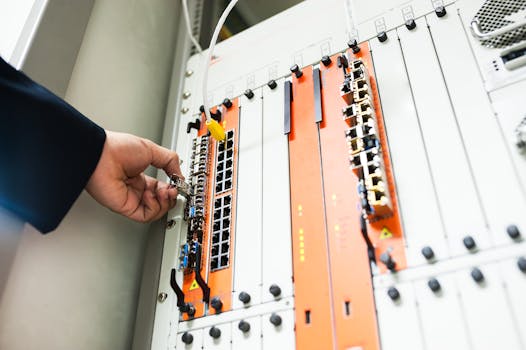The Future of Telecommunications: Spotlight on Africa’s Fiber Companies
Africa’s fiber companies are revolutionizing the telecommunications industry, providing faster and more reliable internet connectivity to the continent. This article explores the future of telecommunications in Africa, highlighting the key players and innovations driving the industry forward.

The Future of Telecommunications: Spotlight on Africa’s Fiber Companies
The future of telecommunications is rapidly evolving, and Africa is at the forefront of this revolution. The focus keyword Future of Telecommunications is becoming increasingly important as the continent’s fiber companies are playing a crucial role in shaping the industry. With the increasing demand for faster and more reliable internet connectivity, Africa’s fiber companies are investing heavily in infrastructure development, providing high-speed internet services to individuals, businesses, and governments across the continent.
Africa’s fiber companies are driving innovation and growth in the telecommunications industry, with many countries on the continent experiencing significant improvements in internet connectivity. According to a report by the International Telecommunication Union (ITU), the number of internet users in Africa has increased significantly over the past decade, with many countries achieving high levels of internet penetration. For example, countries such as South Africa, Nigeria, and Kenya have achieved internet penetration rates of over 50%, with many other countries on the continent also making significant progress.
The Rise of Fiber Optic Connectivity in Africa
The rise of fiber optic connectivity in Africa is one of the most significant developments in the telecommunications industry on the continent. Fiber optic cables have the capacity to transmit large amounts of data at incredibly high speeds, making them ideal for providing high-speed internet services. Many of Africa’s fiber companies are investing in the development of fiber optic infrastructure, including undersea cables, terrestrial fiber optic cables, and last-mile connectivity solutions.
One of the key benefits of fiber optic connectivity is its ability to provide high-speed internet services to remote and underserved areas. Many of Africa’s rural areas have historically been underserved by traditional telecommunications infrastructure, but the development of fiber optic connectivity is helping to bridge this gap. For example, companies such as Liquid Telecom and MTN are investing in the development of fiber optic infrastructure in rural areas, providing high-speed internet services to communities that were previously unserved or underserved.
Key Players in Africa’s Fiber Industry
There are several key players in Africa’s fiber industry, including Liquid Telecom, MTN, and Vodacom. These companies are investing heavily in the development of fiber optic infrastructure, providing high-speed internet services to individuals, businesses, and governments across the continent. Other companies, such as SEACOM and Main One, are also playing important roles in the development of Africa’s fiber industry, providing undersea and terrestrial fiber optic connectivity solutions.
Liquid Telecom, for example, has established itself as one of the leading fiber companies in Africa, with a network of over 70,000 kilometers of fiber optic cable spanning across 13 countries on the continent. The company provides a range of services, including high-speed internet, voice, and data center services, to individuals, businesses, and governments. MTN, another leading fiber company in Africa, has also invested heavily in the development of fiber optic infrastructure, providing high-speed internet services to millions of customers across the continent.
Innovations Driving the Future of Telecommunications in Africa
There are several innovations driving the future of telecommunications in Africa, including the development of 5G technology, the Internet of Things (IoT), and artificial intelligence (AI). These innovations are expected to have a significant impact on the telecommunications industry, providing faster and more reliable internet connectivity, as well as new services and applications.
The development of 5G technology, for example, is expected to provide faster and more reliable internet connectivity, with speeds of up to 10 gigabits per second. This will enable the widespread adoption of applications such as virtual and augmented reality, as well as the IoT. The IoT, which refers to the network of physical devices, vehicles, and other items that are embedded with sensors, software, and connectivity, is expected to have a significant impact on industries such as healthcare, transportation, and manufacturing.
Challenges Facing Africa’s Fiber Industry
Despite the significant progress made by Africa’s fiber companies, there are still several challenges facing the industry. One of the main challenges is the high cost of deploying fiber optic infrastructure, particularly in rural areas. The cost of deploying fiber optic cables can be prohibitively expensive, making it difficult for companies to provide high-speed internet services to remote and underserved areas.
Another challenge facing Africa’s fiber industry is the lack of regulatory framework and policy support. Many countries on the continent lack a clear regulatory framework and policy support for the development of fiber optic infrastructure, making it difficult for companies to invest in the industry. Additionally, the lack of skills and expertise in the industry is also a significant challenge, making it difficult for companies to deploy and maintain fiber optic infrastructure.
Conclusion
In conclusion, the future of telecommunications in Africa is rapidly evolving, with the continent’s fiber companies playing a crucial role in shaping the industry. The development of fiber optic connectivity is providing faster and more reliable internet services to individuals, businesses, and governments across the continent. While there are still several challenges facing the industry, the potential for growth and innovation is significant, and Africa’s fiber companies are well-positioned to drive this growth and innovation.




